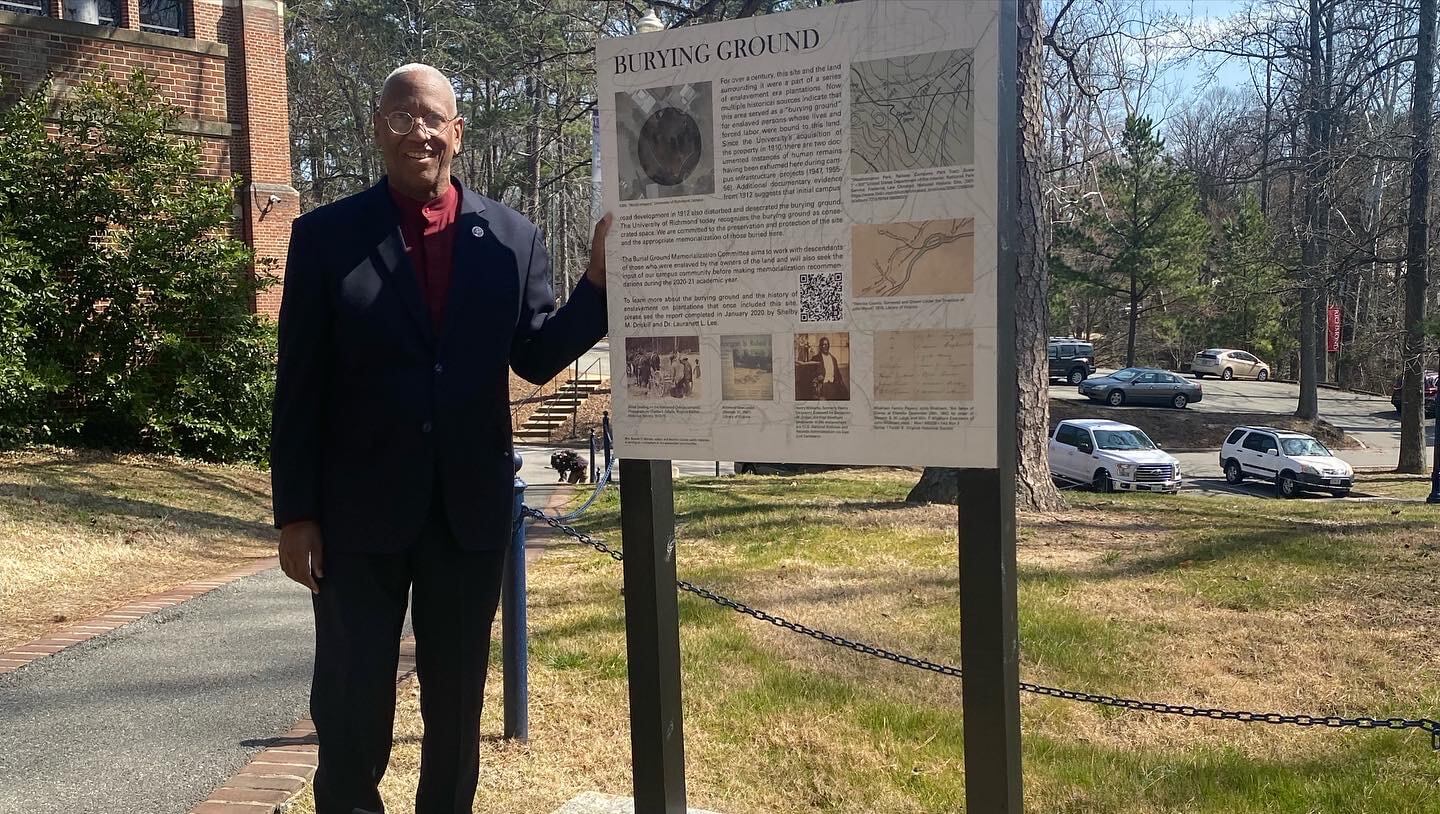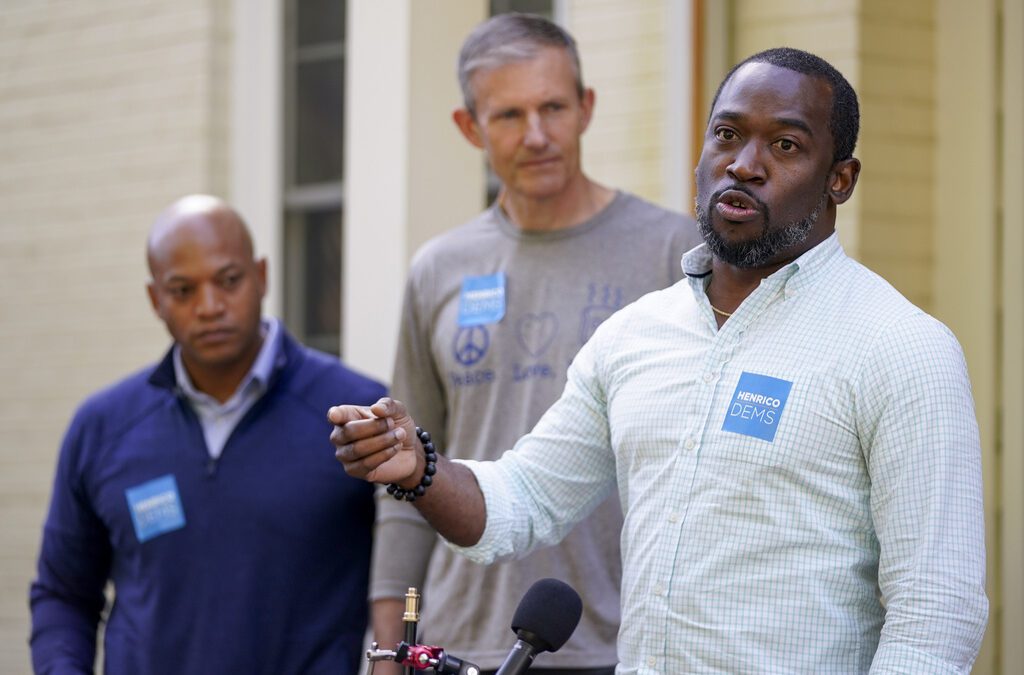
Photo Credit: The Office of Donald McEachin
The African American Burial Grounds Preservation Act would establish a National Park Service program aimed toward preserving Black cemeteries.
When a loved one dies, it’s tradition to pay respect to their final resting place. But for some families, an ancestor’s gravesite has been nearly lost—or in some cases completely lost—to history. Disproportionally, the impact falls on the African American community, and that’s largely due to slavery. Rep. Donald McEachin, a Democrat, is working to change that through new legislation.
McEachin, who serves a district spanning from Richmond to Hampton Roads, announced the introduction of the bipartisan African American Burial Grounds Preservation Act at the University of Richmond, which has a burial ground on its campus.
According to McEachin’s office, the act would establish a program at the National Park Service to provide grant opportunities and technical assistance to help research, identify, survey, and preserve the historic sites at a budget of $3 million per year.
The representative started his remarks on the proposed act by hinting toward getting in trouble, stating: “It is critical. It is based on race. And it is fact. It is not theory.”
McEachin noted that over the years, with no governmental assistance, many African American burial sites were lost due to a lack of tracking and designation, as well as to the elements and overgrowth.
“The preservation of African American burial grounds is of the utmost importance and imperative if we’re going to have a better, more comprehensive understanding of our nation’s history,” McEachin said at the announcement. “This year’s legislation, the African American Burial Grounds Preservation Act, takes more immediate steps by establishing great opportunities and providing technical assistance from the National Park Service to preserve these sites.”
History Lost
We may never know the total number of enslaved individuals involved in the slave trade to the New World. However, the Trans-Atlantic Slave Trade Database provides a working estimate. Between 1525 and 1866, the database calculated figures to include about 12.5 million Africans who had passage on slave ships, with only 10.7 million of those individuals surviving the trip. Of those, most went to the Caribbean and South America, and approximately 388,000 came to North America.
Once the enslaved individuals reached American soil, the population quickly multiplied. Between 1619 when the first African people arrived in Virginia until the Civil War ended in 1865, researcher J. David Hacker estimated that approximately 10 million slaves lived in America.
Unfortunately, there aren’t 10 million graves marking their existence. In fact, to our knowledge, there’s not a comprehensive list of marked slave graves in America, so there’s no way to quickly estimate how many enslaved people attained proper recognition postmortem.
Over the last decade, a collective group including the Periwinkle Initiative, Fordham University, the National Endowment for the Humanities, and the 1772 Foundation have worked toward compiling a National Burial Database of Enslaved Americans. So far a 68-page “Memory & Landmarks” manuscript exists from the project, with more research options slated for the future.
Granting Recognition
Del. Delores McQuinn and Sen. Ghazala Hashmi, both Democrats, joined McEachin at the African American Burial Grounds Preservation Act announcement event.
McQuinn noted some of the various struggles African Americans faced throughout the nation’s history, including slavery and the Jim Crow laws that allowed segregation in cemeteries. She likened the preservation of Black burial grounds to the biblical account of breathing life into dry bones.
“This landmark and bipartisan piece of legislation that has been introduced is a monumental effort in raising the acknowledgment that these sacred sites of abandonment and significant places are relevant to America’s history. They are a part of American history,” McQuinn said. “For entirely too long, the preservation of African American cemeteries were out of sight, therefore out of mind. Hidden in the boughs of vegetation, trees, roots, and even asphalt, were buried names of individuals who contributed to the economic prosperity, to be truthful of white slave owners, traders, and their families.”
Hashmi said that some preservation legislation and programs were already at work on a state level, but noted that none specifically targeted cultural and historic sites of Black, indigenous, or People of Color communities.
“Our story of Virginia has been absolutely incomplete without this level of support,” Hashmi said.
A Continuing Issue
Unfortunately, the end of slavery in 1865 and the abolishment of the Jim Crow laws in the mid-1960s didn’t solve all interment issues. Some African American burial grounds continued to go unmarked or fall into disrepair—even into the 2000s.
In Martinsville, three African American cemeteries exist including the Matthews Cemetery, the People’s Cemetery, and the Smith Street Cemetery. By 2017, the People’s Cemetery—which is actually three adjacent cemeteries also including the A & H (or Anglin and Hairston) Cemetery and Watkins Cemetery—fell into such disrepair that Martinsville Sheriff Steve Draper helped organize an inmate cleanup of the property.
Near Richmond, efforts continue to restore the 1897 East End Cemetery. In 1959, the African American cemetery switched ownership and the new proprietors stopped ground maintenance, expecting families of those interred to perform the upkeep.
While efforts to reclaim the grounds started in the late 1990s and continued with volunteer efforts in 2013, a group called Enrichmond petitioned for the commonwealth’s approval to assume ownership and stewardship of the abandoned cemetery in 2018, which the state granted one year later. Now, efforts are underway to restore and preserve the property.
There’s also work taking place at the University of Richmond’s burial ground, where Kevin Hallock serves as the institution’s president. Hallock spoke about the memorial project at McEachin’s announcement.
“Preserving African American burial grounds contributes to a fuller and more accurate understanding of American history. Confronting the past is challenging, especially when it surfaces uncomfortable truths, but it’s the right thing to do,” Hallock said. “I’m proud of the excellent work of the University of Richmond’s Burying Ground Memorialization Committee in recommending design concepts for a memorial to honor the enslaved persons who lived and labored on the land that is now our campus, and a burial ground in which we believe some were laid to rest—and I’m grateful to the committee for so thoughtfully engaging our campus and broader community in constructive dialogue about this important history.”
Keith McIntosh, University of Richmond’s vice president for information services and co-chair of the university’s Burying Ground Memorialization Committee, noted that the overall design plans to keep the burial site “sacred and lightly touched,” while also being unique, accessible, and inviting.
Politics

Biden administration bans noncompete clauses for workers
The Federal Trade Commission (FTC) voted on Tuesday to ban noncompete agreements—those pesky clauses that employers often force their workers to...

Democratic shakeup in Virginia primaries for governor, lieutenant governor
Richmond Mayor Levar Stoney quit his bid for governor and jumped into the race to be the Democratic nominee for lieutenant governor. The race for...
Local News

Virginia verses: Celebrating 5 poetic icons for National Poetry Month
There’s no shortage of great writers when it comes to our commonwealth. From the haunting verses of Edgar Allan Poe, who found solace in Richmond's...

Join the fun: Recapping Family Literacy Night’s storybook adventures
When’s the last time you read a book aloud with a loved one? If it’s difficult to answer that question, then maybe it’s time to dust off that TBR...





